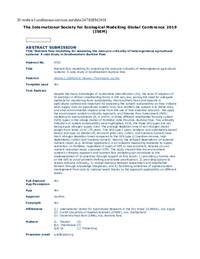Nutrient flow modelling for assessing the resource criticality of heterogeneous agricultural systems: A case study in Southwestern Burkina Faso

Authors:
Despite the many advantages of sustainable intensification (SI), the level of adoption of SI practices in African smallholding farms is still very low, posing the need for adequate methods for monitoring farm sustainability. Macronutrient flows and balance in agricultural systems are important for assessing the system sustainability as they indicate what supply risks an agricultural system runs, how resilient the system is to these risks, and what environmental impacts arise from the use of that essential resource. We apply the environment system’s criticality approach, and Material Flow Assessment (MFA) modelling to macronutrients (N, P, and K) in three different smallholder farming system (SFS) types in the village cluster of Pontieba, Ioba Province, Burkina Faso. Two criticality indicators of system sustainability were highlighted. First, the three SFS types are not facing equal nitrogen supply risks. The average depletion time of soil nitrogen stocks ranges from some 10 to 170 years. The SFS type I (poor, landless, and subsistence-based farms) and type III (better-off, land-and labor-rich, cotton- and livestock-turned) have short nitrogen depletion times compared to the SFS type II (medium-income, high dependency, cotton-and livestock-turned). Second, the reduced dependency on external nutrient inputs (e.g. fertilizer application) is an indicator measuring resilience to supply restriction. In Pontieba, regardless of types of SFS or macronutrient, reliance on own nutrient resources never surpasses 50%. The study showed that the environment system’s criticality approach and nutrient flow modelling can contribute to the implementation of SI practices through support at four levels: 1) providing a holistic view on the SFS to avoid problem-shifting and enable prioritization, 2) providing options to reduce resource criticality, 3) mutual learning between researchers and smallholder farmers through knowledge integration, and 4) facilitating coherence of agroecosystem management from local to national levels thanks to the approach applicability on different scales.
